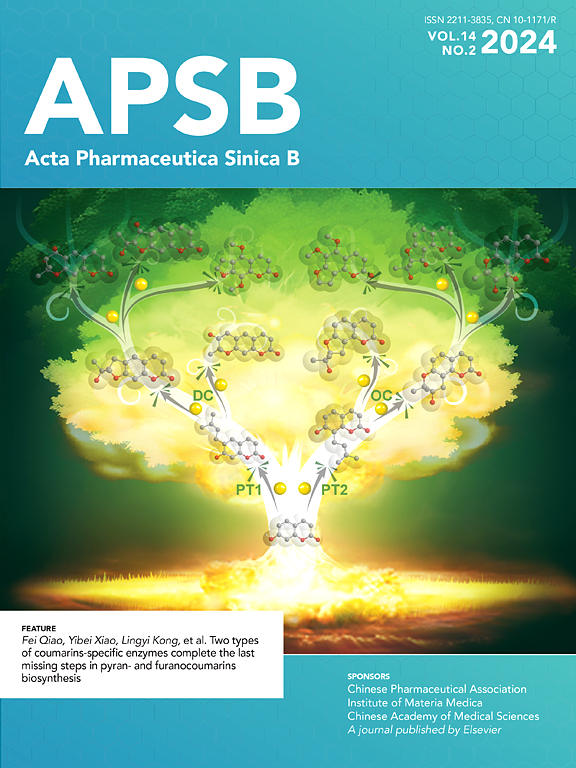Dihydromyricetin mitigates abdominal aortic aneurysm via transcriptional and post-transcriptional regulation of heme oxygenase-1 in vascular smooth muscle cells
IF 14.7
1区 医学
Q1 PHARMACOLOGY & PHARMACY
引用次数: 0
Abstract
Abdominal aortic aneurysm (AAA) is a deadly condition of the aorta, carrying a significant risk of death upon rupture. Currently, there is a dearth of efficacious pharmaceutical interventions to impede the advancement of AAA and avert it from rupturing. Here, we investigated dihydromyricetin (DHM), one of the predominant bioactive flavonoids in Ampelopsis grossedentata (A. grossedentata), as a potential agent for inhibiting AAA. DHM effectively blocked the formation of AAA in angiotensin II-infused apolipoprotein E-deficient (ApoE−/−) mice. A combination of network pharmacology and whole transcriptome sequencing analysis revealed that DHM’s anti-AAA action is linked to heme oxygenase (HO)-1 (Hmox-1 for the rodent gene) and hypoxia-inducible factor (HIF)-1α in vascular smooth muscle cells (VSMCs). Remarkably, DHM caused a robust rise (∼10-fold) of HO-1 protein expression in VSMCs, thereby suppressing VSMC inflammation and oxidative stress and preserving the VSMC contractile phenotype. Intriguingly, the therapeutic effect of DHM on AAA was largely abrogated by VSMC-specific Hmox1 knockdown in mice. Mechanistically, on one hand, DHM increased the transcription of Hmox-1 by triggering the nuclear translocation and activation of HIF-1α, but not nuclear factor erythroid 2-related factor 2 (NRF2). On the other hand, molecular docking, combined with cellular thermal shift assay (CETSA), isothermal titration calorimetry (ITC), drug affinity responsive target stability (DARTS), co-immunoprecipitation (Co-IP), and site mutant experiments revealed that DHM bonded to HO-1 at Lys243 and prevented its degradation, thereby resulting in considerable HO-1 buildup. In summary, our findings suggest that naturally derived DHM has the capacity to markedly enhance HO-1 expression in VSMCs, which may hold promise as a therapeutic strategy for AAA.

二氢杨梅素通过对血管平滑肌细胞血红素氧化酶-1的转录和转录后调控减轻腹主动脉瘤
腹主动脉瘤(AAA)是一种致命的主动脉疾病,一旦破裂就有很大的死亡风险。目前,缺乏有效的药物干预来阻止AAA的进展,避免其破裂。在这里,我们研究了二氢杨梅素(DHM),一种主要的生物活性黄酮类化合物,作为抑制AAA的潜在药物,在血管紧张素ii注入的载脂蛋白e缺陷(ApoE−/−)小鼠中,DHM有效地阻断了AAA的形成。结合网络药理学和全转录组测序分析发现,DHM的抗aaa作用与血管平滑肌细胞(VSMCs)中的血红素加氧酶(HO)-1(啮齿动物基因Hmox-1)和缺氧诱导因子(HIF)-1α有关。值得注意的是,DHM引起VSMC中HO-1蛋白表达的强劲上升(约10倍),从而抑制VSMC炎症和氧化应激,并保持VSMC收缩表型。有趣的是,DHM对AAA的治疗作用在很大程度上被小鼠vsmc特异性Hmox1敲低所抵消。在机制上,DHM一方面通过触发核易位和HIF-1α的激活来增加Hmox-1的转录,但不通过核因子红细胞2相关因子2 (NRF2)。另一方面,分子对接、结合细胞热移测定(CETSA)、等温滴定量热法(ITC)、药物亲和反应靶稳定性(DARTS)、共免疫沉淀(Co-IP)和位点突变实验表明,DHM在Lys243位点与HO-1结合并阻止其降解,从而导致HO-1大量积累。总之,我们的研究结果表明,天然来源的DHM具有显著增强VSMCs中HO-1表达的能力,这可能有望作为AAA的治疗策略。
本文章由计算机程序翻译,如有差异,请以英文原文为准。
求助全文
约1分钟内获得全文
求助全文
来源期刊

Acta Pharmaceutica Sinica. B
Pharmacology, Toxicology and Pharmaceutics-General Pharmacology, Toxicology and Pharmaceutics
CiteScore
22.40
自引率
5.50%
发文量
1051
审稿时长
19 weeks
期刊介绍:
The Journal of the Institute of Materia Medica, Chinese Academy of Medical Sciences, and the Chinese Pharmaceutical Association oversees the peer review process for Acta Pharmaceutica Sinica. B (APSB).
Published monthly in English, APSB is dedicated to disseminating significant original research articles, rapid communications, and high-quality reviews that highlight recent advances across various pharmaceutical sciences domains. These encompass pharmacology, pharmaceutics, medicinal chemistry, natural products, pharmacognosy, pharmaceutical analysis, and pharmacokinetics.
A part of the Acta Pharmaceutica Sinica series, established in 1953 and indexed in prominent databases like Chemical Abstracts, Index Medicus, SciFinder Scholar, Biological Abstracts, International Pharmaceutical Abstracts, Cambridge Scientific Abstracts, and Current Bibliography on Science and Technology, APSB is sponsored by the Institute of Materia Medica, Chinese Academy of Medical Sciences, and the Chinese Pharmaceutical Association. Its production and hosting are facilitated by Elsevier B.V. This collaborative effort ensures APSB's commitment to delivering valuable contributions to the pharmaceutical sciences community.
 求助内容:
求助内容: 应助结果提醒方式:
应助结果提醒方式:


